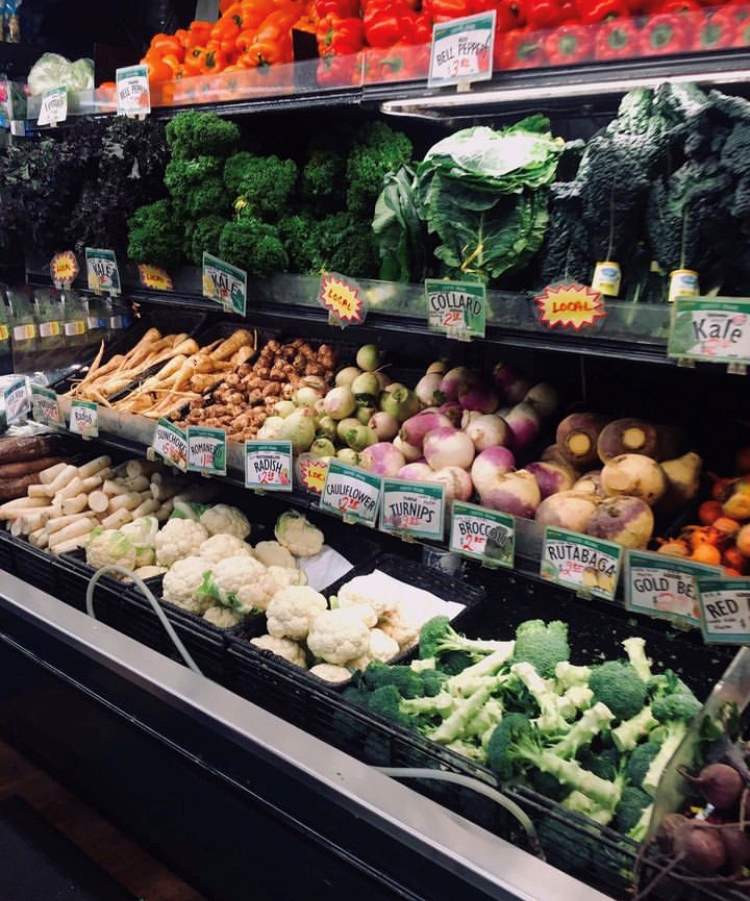Packaging, you know the stuff that most commercial goods are wrapped in, has become a serious problem for our planet. Packaging waste alone makes up 28.8% of all municipal waste created! Almost everything comes in packaging. Even things that should be package-free aren’t anymore. Yeah, I’m looking at you individually wrapped sweet potatoes!
A shocking 23% of the materials being sent to landfills are just food-related containers and packaging waste! Until corporations move away from single-use packaging, we can choose options that have the smallest footprint. So, let’s talk about my top 5 low-impact grocery shopping tips that will you save money while also reducing waste!
1. Bring your own bags.
Instead of bagging your groceries in a single-use bag, bring reusable ones! Buying more stuff is part of the problem but, if you use them, the reusable bags are worth it to reduce single-use packaging waste. You can also reuse paper or plastic bags you may have gotten in the past because this will extend its life and lessen its footprint.
The same applies to produce bags. Like, seriously, you don’t need to put your onion in its own plastic bag! Get some reusable produce bags or reuse produce bags you already have. You can also make your own produce bags out of old material (like old pillowcases or shirts!) and that’s an amazing option to further repurpose the things you already have to avoid creating more waste.
2. Use bulk bins.
Bulk bins are amazing because you use your own container and can get exactly how much you want. Often the food in bulk bins tends to be cheaper than their packaged counterparts too! Bulk bins are going mainstream in the US so there is a lot more access to them now but in case you aren’t familiar and need help finding a store with bulk bins there are plenty of tools to help your search!
If you don’t have access to a devoted bulk bin section in a store near you don’t fret! Instead, try to buy the bigger option. I’m not suggesting buying something that wouldn’t keep and get fully eaten, because that would contribute to our food waste problem. But, buying the bigger option does reduce packaging waste. Think about it, a ten-pound bag of rice has less packaging than ten one-pound bags of rice! So, buying more things in bulk (whether that’s in a bulk bin or just a bulk size) is a great way to make your grocery run less impactful on the environment.
3. Buy less pre-made food.
Everyone has different circumstances and access to things, but at the end of the day, buying less pre-made food lessens the impact of your grocery trip. Regardless of your situation, eating more whole foods and less pre-made foods will always have a lower footprint. So, I encourage you to get creative in the kitchen!
Cooking is an insanely useful skill and, as long as you can dedicate some time to it, you’ll get some amazing pay-off for putting in that work. Home-cooked food is cheaper and you can tweak recipes to make it exactly to your taste preferences. Make some sustainable snacks or just cook more meals at home! You’ll hone your cooking skills, eat healthier, save money, and reduce packaging waste.
4. Choose better packaging.
There are some cases where you’re just going to have to buy something with packaging. So, when that happens reach for the options with more eco-friendly packaging. Aim to buy things with compostable or recyclable packaging. Materials like glass, metal, and paper are all heaps better than plastic and can be much more widely available than zero-waste options.
Buy peanut butter that comes in a glass jar instead of a plastic one! Or reach for a box of pasta instead of pasta that comes in a plastic bag. By choosing better packaging the odds of those materials getting repurposed and reused are so much higher. That’ll cut the amount of waste going to the landfill and in the long run make a huge difference.
5. Support farmers markets.
Going to farmers markets not only supports people in your community, but it cuts down on packaging waste and shipping emissions. A lot of farm stands will even reuse packaging if you return it which cuts waste and helps out the farmer! Although, in my experience, most options at farmers markets inherently don’t come in packaging to begin with which makes it super easy to majorly reduce packaging waste.
Plus, visiting farmers markets means you’ll have access to better quality seasonal produce which is another major sustainability win! If you don’t have a local farmers market near you then utilize your loose produce section and deli section. These are great options for avoiding unnecessary plastic and styrofoam that can be found in just about every grocery store.
To reduce packaging waste when grocery shopping:
- Bring your own bags.
- Use bulk bins.
- Buy less pre-made food.
- Choose better packaging.
- Support farmer’s markets.
Our overconsumption habits and unsustainable resource use are the main culprits as to why we are not set to meet climate goals. Until there is a large-scale shift we can act with our dollar! The stuff we buy has influence, by buying things with less packaging we can drive up demands for more eco-conscious goods.
Not everyone has access to or can even afford zero-waste options but these are 5 easy, cost-effective, and accessible ways anyone can make their grocery trips low-impact. Hopefully, the more people who choose less wasteful options, the more companies will align themselves with these values. You don’t need to be perfect, just doing what you can to lessen the strain we put on the environment will move us towards a greener future.

